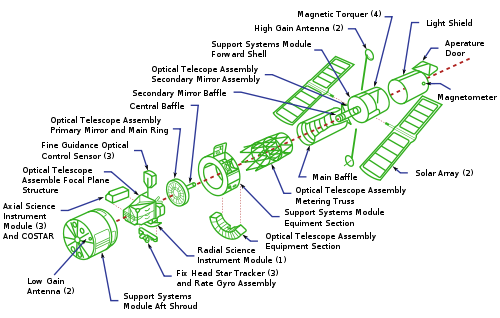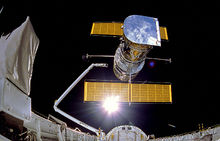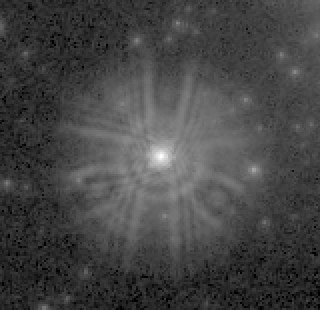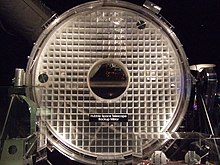Spacecraft systems
The spacecraft in which the telescope and instruments were to be housed was another major engineering challenge. It would have to adequately withstand frequent passages from direct sunlight into the darkness of Earth's shadow, which would generate major changes in temperature, while being stable enough to allow extremely accurate pointing of the telescope. A shroud of multi-layer insulation keeps the temperature within the telescope stable, and surrounds a light aluminum shell in which the telescope and instruments sit. Within the shell, a graphite-epoxy frame keeps the working parts of the telescope firmly aligned.[31] Because graphite composites are hygroscopic, there was a risk that water vapor absorbed by the truss while in Lockheed's clean room would later be expressed in the vacuum of space; the telescope's instruments would be covered in ice. To reduce that risk, a nitrogen gas purge was performed prior to launching the telescope into space.[32]
While construction of the spacecraft in which the telescope and instruments would be housed proceeded somewhat more smoothly than the construction of the OTA, Lockheed still experienced some budget and schedule slippage, and by the summer of 1985, construction of the spacecraft was 30% over budget and three months behind schedule. An MSFC report said that Lockheed tended to rely on NASA directions rather than take their own initiative in the construction.[33]
Initial instruments
Main articles: Wide Field and Planetary Camera, Goddard High Resolution Spectrograph, High Speed Photometer,Faint Object Camera, and Faint Object Spectrograph
When launched, the HST carried five scientific instruments: the Wide Field and Planetary Camera (WF/PC), Goddard High Resolution Spectrograph (GHRS), High Speed Photometer (HSP), Faint Object Camera (FOC) and the Faint Object Spectrograph (FOS). WF/PC was a high-resolution imaging device primarily intended for optical observations. It was built by NASA's Jet Propulsion Laboratory, and incorporated a set of 48 filters isolatingspectral lines of particular astrophysical interest. The instrument contained eight charge-coupled device (CCD) chips divided between two cameras, each using four CCDs. The "wide field camera" (WFC) covered a large angular field at the expense of resolution, while the "planetary camera" (PC) took images at a longer effective focal length than the WF chips, giving it a greater magnification.[34]
The GHRS was a spectrograph designed to operate in the ultraviolet. It was built by the Goddard Space Flight Center and could achieve a spectral resolution of 90,000.[35] Also optimized for ultraviolet observations were the FOC and FOS, which were capable of the highest spatial resolution of any instruments on Hubble. Rather than CCDs these three instruments used photon-counting digicons as their detectors. The FOC was constructed by ESA, while the University of California, San Diego and the Martin Marietta corporation built the FOS.[34]
The final instrument was the HSP, designed and built at the University of Wisconsin–Madison. It was optimized for visible and ultraviolet light observations of variable stars and other astronomical objects varying in brightness. It could take up to 100,000 measurements per second with a photometric accuracy of about 2% or better.[36]
HST's guidance system can also be used as a scientific instrument. Its three Fine Guidance Sensors (FGS) are primarily used to keep the telescope accurately pointed during an observation, but can also be used to carry out extremely accurate astrometry; measurements accurate to within 0.0003 arcseconds have been achieved.[37]
Ground support
Main article: Space Telescope Science Institute
The Space Telescope Science Institute (STSI) is responsible for the scientific operation of the telescope and delivery of data products to astronomers. STScI is operated by theAssociation of Universities for Research in Astronomy (AURA) and is physically located inBaltimore, Maryland on the Homewood campus of Johns Hopkins University, one of the 33 US universities and 7 international affiliates that make up the AURA consortium. STScI was established in 1981 [38] after something of a power struggle between NASA and the scientific community at large. NASA had wanted to keep this function "in-house", but scientists wanted it to be based in an academic establishment.[39][40] The Space Telescope European Coordinating Facility (ST-ECF), established at Garching bei München near Munich in 1984, provides similar support for European astronomers.
One rather complex task that falls to STScI is scheduling observations for the telescope.[41]Hubble is situated in a low-Earth orbit so that it can be reached by the space shuttle for servicing missions, but this means that most astronomical targets are occulted by the Earth for slightly less than half of each orbit. Observations cannot take place when the telescope passes through the South Atlantic Anomaly due to elevated radiation levels, and there are also sizable exclusion zones around the Sun (precluding observations of Mercury), Moon and Earth. The solar avoidance angle is about 50°, which is specified to keep sunlight from illuminating any part of the OTA. Earth and Moon avoidance is to keep bright light out of the FGSs and to keep scattered light from entering the instruments. If the FGSs are turned off, however, the Moon and Earth can be observed. Earth observations were used very early in the program to generate flat-fields for the WFPC1 instrument. There is a so-called continuous viewing zone (CVZ), at roughly 90 degrees to the plane of Hubble's orbit, in which targets are not occulted for long periods. Due to the precession of the orbit, the location of the CVZ moves slowly over a period of eight weeks. Because the limb of the Earth is always within about 30° of regions within the CVZ, the brightness of scattered earthshine may be elevated for long periods during CVZ observations.
Because Hubble orbits in the upper atmosphere, its orbit changes over time in a way that is not accurately predictable. The density of the upper atmosphere varies according to many factors, and this means that Hubble's predicted position for six weeks' time could be in error by up to 4,000 km. Observation schedules are typically finalized only a few days in advance, as a longer lead time would mean there was a chance that the target would be unobservable by the time it was due to be observed.[42]
Engineering support for HST is provided by NASA and contractor personnel at the Goddard Space Flight Center in Greenbelt, Maryland, 48 km south of the STScI. Hubble's operation is monitored 24 hours per day by four teams of flight controllers who make up Hubble's Flight Operations Team.[43]
Challenger disaster, delays, and eventual launch
By early 1986, the planned launch date of October that year looked feasible, but the Challenger accident brought the U.S. space program to a halt, grounding the space shuttle fleet and forcing the launch of Hubble to be postponed for several years. The telescope had to be kept in a clean room, powered up and purged with nitrogen, until a launch could be rescheduled. This costly situation (about $6 million per month) pushed the overall costs of the project even higher. This delay did allow time for engineers to perform extensive tests, swap out a possibly failure-prone battery, and make other improvements.[44] Furthermore, the ground software needed to control Hubble was not ready in 1986, and in fact was barely ready by the 1990 launch.[45]
Eventually, following the resumption of shuttle flights in 1988, the launch of the telescope was scheduled for 1990. On April 24, 1990, shuttle mission STS-31 saw Discovery launch the telescope successfully into its planned orbit.[46]
From its original total cost estimate of about US$400 million, the telescope had by now cost over $2.5 billion to construct. Hubble's cumulative costs up to this day are estimated to be several times higher still, with US expenditure estimated at between $4.5 and $6 billion, and Europe's financial contribution at €593 million (1999 estimate).[47]
Flawed mirror
Within weeks of the launch of the telescope, the returned images showed that there was a serious problem with the optical system. Although the first images appeared to be sharper than ground-based images, the telescope failed to achieve a final sharp focus, and the best image quality obtained was drastically lower than expected. Images of point sources spread out over a radius of more than one arcsecond, instead of having a point spread function (PSF) concentrated within a circle 0.1 arcsec in diameter as had been specified in the design criteria.[48] The detailed performance is shown in graphs from STScI illustrating the mis-figured PSFs compared to post-correction and ground-based PSFs.[49]
Analysis of the flawed images showed that the cause of the problem was that the primary mirror had been ground to the wrong shape. Although it was probably the most precisely figured mirror ever made, with variations from the prescribed curve of only 10 nanometers,[21] it was too flat at the edges by about 2200 nanometers (2.2 microns).[50] This difference was catastrophic, introducing severe spherical aberration, a flaw in which light reflecting off the edge of a mirror focuses on a different point from the light reflecting off its center.[51]
The effect of the mirror flaw on scientific observations depended on the particular observation—the core of the aberrated PSF was sharp enough to permit high-resolution observations of bright objects, and spectroscopy was largely unaffected. However, the loss of light to the large, out of focus halo severely reduced the usefulness of the telescope for faint objects or high-contrast imaging. This meant that nearly all of the cosmological programs were essentially impossible, since they required observation of exceptionally faint objects.[51]NASA and the telescope became the butt of many jokes, and the project was popularly regarded as a white elephant. (For instance, in the 1991 comedy The Naked Gun 2½: The Smell of Fear, the Hubble was pictured with the Titanic, the Hindenburg, and the Edsel).[52]Nonetheless, during the first three years of the Hubble mission, before the optical corrections, the telescope still carried out a large number of productive observations. The error was well characterized and stable, enabling astronomers to optimize the results obtained using sophisticated image processingtechniques such as deconvolution.[53]
Origin of the problem
A commission headed by Lew Allen, director of the Jet Propulsion Laboratory, was established to determine how the error could have arisen. The Allen Commission found that the main null corrector, a device used to measure the exact shape of the mirror, had been incorrectly assembled—one lens was wrongly spaced by 1.3 mm.[55] During the polishing of the mirror, Perkin-Elmer had analyzed its surface with two other null correctors, both of which correctly indicated that the mirror was suffering from spherical aberration. The company ignored these test results, as it believed that the two null correctors were less accurate than the primary device that was reporting that the mirror was perfectly figured.[56]
The commission blamed the failings primarily on Perkin-Elmer. Relations between NASA and the optics company had been severely strained during the telescope construction, due to frequent schedule slippage and cost overruns. NASA found that Perkin-Elmer did not review or supervise the mirror construction adequately, did not assign its best optical scientists to the project (as it had for the prototype), and in particular did not involve the optical designers in the construction and verification of the mirror. While the commission heavily criticized Perkin-Elmer for these managerial failings, NASA was also criticized for not picking up on the quality control shortcomings, such as relying totally on test results from a single instrument.[57]
Design of a solution
The design of the telescope had always incorporated servicing missions, and astronomers immediately began to seek potential solutions to the problem that could be applied at the first servicing mission, scheduled for 1993. While Kodak and Itek had each ground back-up mirrors for Hubble, it would have been impossible to replace the mirror in orbit, and too expensive and time-consuming to bring the telescope temporarily back to Earth for a refit. Instead, the fact that the mirror had been ground so precisely to the wrong shape led to the design of new optical components with exactly the same error but in the opposite sense, to be added to the telescope at the servicing mission, effectively acting as "spectacles" to correct the spherical aberration.[58][59]
The first step was a precise characterization of the error in the main mirror. Working backwards from images of point sources, astronomers determined that the conic constant of the mirror as built was −1.01390±0.0002, instead of the intended −1.00230.[60][61] The same number was also derived by analyzing the null corrector used by Perkin-Elmer to figure the mirror, as well as by analyzing interferograms obtained during ground testing of the mirror.[62]
Because of the way the HST's instruments were designed, two different sets of correctors were required. The design of the Wide Field and Planetary Camera 2, already planned to replace the existing WF/PC, included relay mirrors to direct light onto the eight separateCCD chips making up its two cameras. An inverse error built into their surfaces could completely cancel the aberration of the primary. However, the other instruments lacked any intermediate surfaces that could be figured in this way, and so required an external correction device.[63]
The Corrective Optics Space Telescope Axial Replacement (COSTAR) system was designed to correct the spherical aberration for light focused at the FOC, FOS, and GHRS. It consists of two mirrors in the light path with one ground to correct the aberration.[64] To fit the COSTAR system onto the telescope, one of the other instruments had to be removed, and astronomers selected the High Speed Photometer to be sacrificed.[63] By 2002 all of the original instruments requiring COSTAR had been replaced by instruments with their own corrective optics.[65] COSTAR was removed and returned to Earth in 2009 where it is exhibited at the National Air and Space Museum. The area previously used by COSTAR is now occupied by the Cosmic Origins Spectrograph.































No comments:
Post a Comment